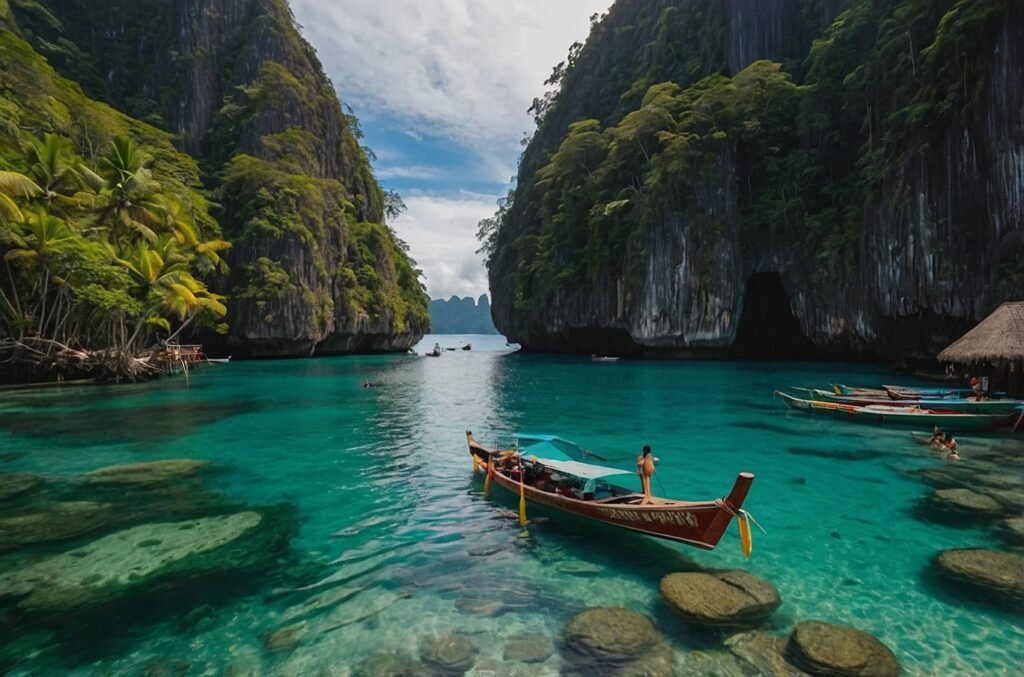The Philippine tourism industry has been experiencing significant growth in recent years, emerging as a vital contributor to the country’s economy. With its diverse array of natural wonders, rich cultural heritage, and warm hospitality, the Philippines has steadily positioned itself as an attractive destination for both domestic and international travelers. This blog post will delve into the various aspects of the Philippine tourism sector, exploring its current state, key attractions, economic impact, challenges, and future prospects. By examining these factors, we aim to provide a comprehensive overview of the burgeoning tourism industry in the Philippines and its potential for further expansion.
Historical Context of Philippine Tourism
The development of tourism in the Philippines can be traced back to the post-World War II era when the country began to recognize the potential of its natural and cultural resources as attractions for visitors. However, it was not until the 1970s that the government started to implement more structured policies to promote tourism. The creation of the Department of Tourism (DOT) in 1973 marked a significant milestone in the country’s efforts to develop its tourism sector.
Over the decades, the Philippines has faced various challenges in its quest to become a premier tourist destination. Political instability, economic fluctuations, and natural disasters have all played roles in shaping the trajectory of the country’s tourism industry. Despite these obstacles, the sector has shown remarkable resilience, adapting to changing global trends and leveraging its unique offerings to attract an increasing number of visitors.
In recent years, the Philippine government has placed a stronger emphasis on tourism as a driver of economic growth. The implementation of the Tourism Act of 2009 provided a framework for sustainable tourism development, focusing on improving infrastructure, enhancing marketing efforts, and ensuring the preservation of natural and cultural resources. These initiatives have contributed to the steady growth of the tourism sector, making it one of the fastest-growing industries in the country.
Key Tourist Attractions
The Philippines boasts a diverse range of attractions that cater to various interests and preferences. From pristine beaches and lush landscapes to historical sites and vibrant urban centers, the country offers a wealth of experiences for travelers. Some of the most popular destinations include:
Natural Wonders:
- Boracay Island: Known for its powdery white sand beaches and crystal-clear waters
- Palawan: Home to the UNESCO World Heritage Site Puerto Princesa Subterranean River National Park and the picturesque El Nido archipelago
- Bohol: Famous for its Chocolate Hills and tarsier sanctuaries
- Siargao: A surfer’s paradise with world-class waves
Cultural and Historical Sites:
- Intramuros: The historic walled city in Manila, showcasing Spanish colonial architecture
- Vigan: A UNESCO World Heritage Site known for its well-preserved Spanish colonial town
- Banaue Rice Terraces: Ancient terraces carved into the mountains of Ifugao
- Magellan’s Cross: A historical landmark in Cebu City
Urban Destinations:
- Manila: The bustling capital city with a mix of modern and historical attractions
- Cebu City: A major economic hub with a rich history and vibrant culinary scene
- Davao City: Known for its eco-adventures and unique fruits like durian
Adventure and Ecotourism:
- Mount Apo: The highest peak in the Philippines, offering challenging hiking trails
- Tubbataha Reefs Natural Park: A world-renowned diving destination
- Cagayan de Oro: Popular for white water rafting and other adventure activities
These diverse attractions have played a crucial role in attracting both domestic and international tourists, contributing to the growth of the Philippine tourism industry.
Tourism Statistics and Economic Impact
The tourism sector has become an increasingly important contributor to the Philippine economy, generating significant revenue and employment opportunities. Let’s examine some key statistics and economic indicators to illustrate the industry’s growth and impact:
Visitor Arrivals
| Year | International Visitors | Domestic Visitors (in millions) |
|---|---|---|
| 2015 | 5.36 million | 68.32 |
| 2016 | 5.97 million | 85.04 |
| 2017 | 6.62 million | 96.72 |
| 2018 | 7.17 million | 110.79 |
| 2019 | 8.26 million | 123.42 |
| 2020 | 1.48 million | 32.16 |
| 2021 | 0.16 million | 37.28 |
Note: The significant drop in 2020 and 2021 is due to the COVID-19 pandemic.
Economic Contribution
The tourism industry’s contribution to the Philippine economy has been substantial:
- In 2019, tourism accounted for 12.7% of the country’s Gross Domestic Product (GDP).
- The sector generated approximately 5.71 million jobs in 2019, representing 13.5% of total employment.
- Foreign exchange earnings from tourism reached PHP 548.76 billion (approximately USD 10.5 billion) in 2019.
Top Source Markets
The following table shows the top source markets for international visitors to the Philippines in 2019:
| Rank | Country | Number of Visitors |
|---|---|---|
| 1 | South Korea | 1,989,322 |
| 2 | China | 1,743,309 |
| 3 | United States | 1,064,440 |
| 4 | Japan | 682,788 |
| 5 | Taiwan | 327,273 |
These statistics demonstrate the significant growth trajectory of the Philippine tourism industry before the COVID-19 pandemic and its substantial contribution to the national economy. While the sector faced unprecedented challenges in 2020 and 2021, it is expected to recover and continue its growth as global travel restrictions ease.
Government Initiatives and Policies
The Philippine government has implemented various initiatives and policies to support the growth of the tourism industry. These efforts aim to improve infrastructure, enhance marketing strategies, and ensure sustainable development. Some key initiatives include:
National Tourism Development Plan (NTDP)
The NTDP 2016-2022 outlines the government’s strategy for developing the tourism sector. Its main objectives include:
- Enhancing the competitiveness of tourism destinations and products
- Improving market access, connectivity, and destination infrastructure
- Improving institutional governance and human resources
- Fostering sustainable and inclusive tourism
Tourism Infrastructure and Enterprise Zone Authority (TIEZA)
TIEZA is responsible for implementing policies and programs related to the development, promotion, and supervision of tourism infrastructure projects. It focuses on:
- Designating, regulating, and supervising Tourism Enterprise Zones (TEZs)
- Developing tourism infrastructure projects nationwide
- Managing assets previously under the Philippine Tourism Authority
It’s More Fun in the Philippines Campaign
Launched in 2012, this award-winning marketing campaign has successfully promoted the Philippines as a tourist destination globally. The campaign highlights the country’s natural beauty, cultural diversity, and the warm hospitality of its people.
Visa Policy Reforms
The government has implemented various visa policy reforms to make it easier for tourists to visit the Philippines. These include:
- Visa-free entry for citizens of 157 countries for stays up to 30 days
- Visa-on-arrival for Chinese tourists
- Extension of visa-free privileges for Taiwan nationals
Sustainable Tourism Development
The Department of Tourism has emphasized sustainable tourism practices through initiatives such as:
- The Philippine Sustainable Tourism Certification program
- Community-based tourism projects
- Environmental conservation efforts in key tourist destinations
These government initiatives have played a crucial role in supporting the growth of the tourism industry and positioning the Philippines as an attractive destination for travelers from around the world.
Challenges Facing the Philippine Tourism Industry
Despite its growth and potential, the Philippine tourism industry faces several challenges that need to be addressed to ensure sustainable development and competitiveness. Some of the key issues include:
Infrastructure Gaps
The Philippines still lags behind some of its regional competitors in terms of tourism infrastructure. Issues include:
- Limited airport capacity and connectivity in some destinations
- Inadequate road networks and public transportation systems
- Insufficient accommodation options in certain areas
Safety and Security Concerns
Perceptions of safety and security can impact tourism growth. Challenges include:
- Occasional travel advisories issued by foreign governments
- Natural disasters such as typhoons and earthquakes
- Localized security issues in some regions
Environmental Sustainability
The rapid growth of tourism has put pressure on natural resources and ecosystems. Concerns include:
- Overexploitation of popular destinations like Boracay, leading to temporary closures
- Marine pollution and coral reef degradation
- Deforestation and loss of biodiversity in some areas
Workforce Development
Ensuring a skilled workforce to meet the demands of a growing tourism industry is crucial. Challenges include:
- Shortage of trained professionals in certain specialized areas
- Need for continuous training and upskilling of tourism workers
- Brain drain as skilled workers seek opportunities abroad
Marketing and Branding
While the “It’s More Fun in the Philippines” campaign has been successful, there is a need for:
- Diversification of marketing strategies to target new markets
- Addressing misconceptions about the country
- Promoting lesser-known destinations to reduce pressure on popular spots
Regulatory Environment
Streamlining regulations and improving the ease of doing business in the tourism sector remains a challenge. Issues include:
- Complex and sometimes overlapping regulations
- Need for improved coordination among government agencies
- Balancing development with conservation efforts
Addressing these challenges will be crucial for the continued growth and sustainability of the Philippine tourism industry. The government, private sector, and local communities must work together to implement solutions that promote responsible and inclusive tourism development.
Future Prospects and Opportunities
Despite the challenges, the Philippine tourism industry holds significant potential for future growth. Several factors contribute to the optimistic outlook for the sector:
Recovery from the COVID-19 Pandemic
As global travel restrictions ease and vaccination rates increase, the Philippines is well-positioned to benefit from pent-up travel demand. The country’s diverse offerings and natural beauty make it an attractive destination for travelers seeking new experiences post-pandemic.
Digital Transformation
The adoption of digital technologies presents opportunities for:
- Enhanced marketing through social media and digital platforms
- Improved visitor experiences through virtual and augmented reality
- Streamlined operations and customer service through AI and big data analytics
Emerging Niche Markets
The Philippines can capitalize on growing interest in:
- Ecotourism and sustainable travel
- Wellness and medical tourism
- Cultural and heritage tourism
- Adventure and sports tourism
Infrastructure Development
Ongoing and planned infrastructure projects, including:
- New airports and expansion of existing ones
- Improved road networks and public transportation systems
- Development of integrated resorts and tourism complexes
Regional Integration
Increased cooperation within the ASEAN region could lead to:
- Easier travel between member countries
- Joint marketing initiatives
- Sharing of best practices in tourism development
Investment Opportunities
The growing tourism sector presents attractive investment opportunities in areas such as:
- Hotel and resort development
- Tour operations and transportation services
- Eco-lodges and sustainable tourism projects
- Technology solutions for the tourism industry
By leveraging these opportunities and addressing the existing challenges, the Philippine tourism industry is poised for continued growth and development in the coming years.
Conclusion
The tourism industry in the Philippines has demonstrated remarkable growth and resilience over the past decades, emerging as a significant contributor to the country’s economy. With its diverse array of natural wonders, rich cultural heritage, and warm hospitality, the Philippines has established itself as an attractive destination for both domestic and international travelers.
While the industry faces challenges such as infrastructure gaps, sustainability concerns, and the need for skilled workforce development, it also presents numerous opportunities for future growth. The government’s commitment to supporting the sector through various initiatives and policies, coupled with the country’s natural and cultural assets, positions the Philippines well for continued success in the global tourism market.
As the industry recovers from the impacts of the COVID-19 pandemic, stakeholders must focus on sustainable and responsible tourism development. By addressing existing challenges, embracing digital transformation, and capitalizing on emerging trends, the Philippine tourism industry can unlock its full potential and contribute even more significantly to the country’s economic and social development in the years to come.
Disclaimer: This blog post is based on available data and information at the time of writing. While every effort has been made to ensure accuracy, the tourism industry is dynamic and subject to rapid changes. Readers are encouraged to verify current information from official sources. If you notice any inaccuracies, please report them so we can correct them promptly.




